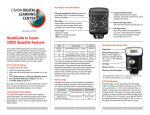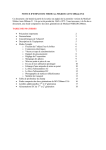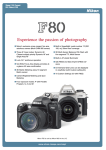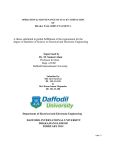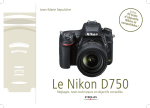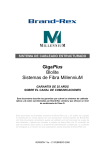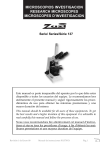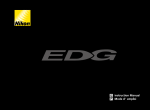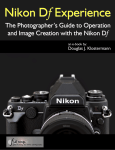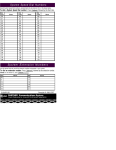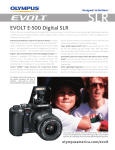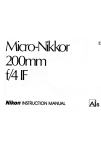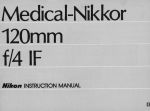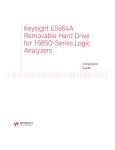Download Nikon Switch SB-10 User's Manual
Transcript
Nikon INSTRUCTION MANUAL NOMENCLATURE Battery com partment Exposure calcul ator Shooting mode indicator Shooting mode se lector Ligh t se nsor Flash lamp 2 Power sw itch Ready-light/ Op en -fl ash button Sync socket Locking nut Mounting foot Ready-I ight contact 3 CONTENTS Foreword . . . . . . . . ... . . . . . . . . . . . . .. 5 Settingup ... .. ... .. .... . . . . . . . . . . . 6 Installing th e batteries . . . . . .. .. . . .. .. 6 Attaching the 58·10 to the camera . . . . . . . 7 Flash synchronization ... .... . . . . . . . .. . 9 Automatic exposure operation .. .... .. .. . 12 Exposure calculator .... . . . . . . . .. .... 12 Setting the f/ number . ....• ... . . . . . . . 14 The reflector ... . . . .... .... . . .. . . .. . 15 'Red Eyes' phen o menon .. . ... ... . .... . . 15 Taking an auto f lash photograph ... .... . .. 16 Ready-light/open-flash button ... .. . .... 16 Ready-light in t he FE camera finder . . . . . . 17 Manual overr id e .. .. . . . . . ... . ... .. ... 17 Multipl e flash operatio n ... .. . . . . . . . . . . . 18 Accesso ries . . . . . . . . . . . . . .. .. . . . . . . . 20 Features/specifications . . . . ... . . . . . . . . . . 22 Camera/ speed light combi nation chart ... . ... 23 4 FOREWORD The Nikon Speedlight SB-10 brings you the advantage of lightweight, compactness and advanced circuitry. The use of a seriescircuit configuration employing silicon-controlled rectifiers ensures that the unit retains all the unused charge in the capacitor for ultra-rapid recycling. When working at a distance of 1 meter and an aperture of f/4 (ASA 100 fil m speed), for instance, recycling time is less than 1 second on automatic operation . Also, since the unused charge in the capacitor is conserved, less battery power is required, and you get more flashes per battery load. Despite the unit's small size, there is no loss of illumination power. An advanced reflector design, coupled with a high-output flash lamp, gives corner-to-corner brightness and even illumination. An accessory clip-on diffuser extends flash coverage up to 67 ° horizontally and 48° vertically, perfect for use with 28mm wideangle lenses. Additionally, the SB-10 has a built-in readylight contact for exclusive use with the Nikon FE camera. This unique feature provides for greater convenience in flash photography . To obtain the best results from this unit, read this instruction manual carefully before use. Keep this booklet handy for quick reference until you have fully mastered operation. A few minutes of preparation will help you avoid costly mistakes. 5 SETTING UP Install ing the Batteries Power is supplied by four 1.5V AA-type batteries. To install the batteries, first depress the knurled surfaces on the top and bottom of the unit. The Battery Holder MS-2 will then pop out at the side . Next, Iift out the holder and insert four batteries, making sure that the positive and negative (+ and - ) terminals are installed according to the diagram inside the ho lder . To replace the battery holder, slip it into the battery compartment until it clicks into place . If you foresee not using your speedlight for some time, it is advisable to remove the batteries for separate storage . This will eliminate the risk of damage caused by leaking batteries . 6 Attaching the S8-1O to the Camera Nikon FE:, EL2 and FM, and Nikkormat EL, ELW, FT2 and FT3 Turn the locking nut on the mounting foot until it reaches the upper limit. Next, slide the mounting foot forward onto the camer a 's accessory shoe as far as it will go . Then retighten the locking nut to prevent the unit from accidentally slipping off. 7 Nikon F2-series and F cameras First, mount the Flash Un it Cou pier AS-' on the camera's accessory shoe . Next, turn the locking nut on the mounting foot of the 58-' 0 until it reaches the upper limit. Then slide the mounting foot forward onto the accessory shoe of the AS-' as far as it will go . Retighten the locking nut to prevent the unit from accidentally slipping off. Nikon R 10 and R8 Super Zoom First, plug the Sync Cord SC-7 into the sync socket on the 58-' O. Next, turn the locking nut on the mounting foot until it reaches the upper limit . Slide the mounting foot forward onto the camera's accessory shoe as far as it will go. Then retighten the locking nut to prevent the unit from accidentally slipping off. I nsert the sync cord contact point into the speedlight sync terminal (7) on the camera. 8 FLASH SYNCHRONIZATION Nikon FE When the camera is in automatic mode, mounting the 58-10 unit onto the FE camera body and turning on both the unit and the camera's meter automatically set the shutter speed of the camera at 1/90 second. And when the readylight built into the eyepiece of the FE camera glows, it indicates readiness for flash shooting. When in manual mode, set the shutter speed at 1/125 sec. or slower . Turn on the unit and when the ready-light lights up, you are ready for flash photography. When the shutter speed is set beyond the camera's sync range, the ready-light flickers as a sync warning signal . However, it is kept lit if the film-advance lever is depressed (i .e ., turning off the meter). The built-in hot shoe contact eliminates the need for a sync cord. With the Nikkormat EL and ELW, first set the shutter speed at 1/125 sec. or slower. Then lift and turn the knurled sync selector ring around the shu tter-speed di al u nti I the Iigh tn ing symbol (7') appears in the selector window. A hotshoe contact built into the mounting foot of the 58-10 eliminates the need for a sync cord. With the Nikon EL2 . and FM, and Nikkormat FT2 and FT3, set the camera shutter speed for 1/125 sec. or slower. Due to the built-in automatic sync switchover mechanism, this is the only step necessary to ensure proper flash operation. The built-in hot shoe contact eliminates the need for a sync cord. 9 With the N ikon F2-series camera, a bu i It-in selector mechanism controls the speedlight sync adjustment automatical ly as you change shutter speeds: simply rotate the shutter-speed dial to the desired setting slower than 1/ 80 sec . The red line between 1/ 60 and 1/ 125 indicates 1/ 80 sec. A hot-shoe contact built into the mounting foot of the 58-10 eliminates the need for a sync cord, although the unit requires the Flash Unit Coupler AS-' for use with F2-series cameras . 10 With the Nikon F, the sync selector is used to adjust the camera for use with speed lights. First set the shutter speed at 1/ 60 sec. or slower. Then Iift and turn the knurled sync se lector ring around the shutter-speed dial of the camera until the FX mark appears in the se lector window. (The Photomic FTN finder must be removed to gain access to t he sync selector ring.) A hot-shoe contact built into the mounting foot of the 58-10 eliminates the need for a sync cord, a lthough the unit requires the Flash Unit Coup ler AS-1 for use with the Nikon F. R 10 and R8 Super Zoom Flash synchronization is possible only with single-frame shooting. Automatic exposure control can be made within the specified distance range. With the R10, depress the lock release button and turn the running speed control dial until the "SF" (Single Frame) mark clicks into place opposite the white index. Then fully open the angle of the shutter blade opening by depressing the shutter blade opening control and turning it clockwise. With the R8, first set the camera at 18 fps, and slide the changeover switch toward the "5" (Single frame) mark. Then fully open the angle of the shutter blade opening by depressing the shutter blade opening control and turning it clockwise . Note that the fully charged SB-10 may fire when mounting it onto the- accessory shoe of either R10 or R8. To avoid this, insert the Sync Cord SC-7 in the sync socket on the speedlight unit before mounting it on the cine camera. 11 AUTOMATIC EXPOSURE OPERATION The S8-1O co ntrol s the amount of Iight o utput depending o n the flash-to-subject distance. The further away the subject is, the more li ght it em its; the closer the subject, the less it emits. In ad dition, the recycling time changes with the di stance. The closer th e subject, the sh o rter t he recyc ling ti me . Exposure Calculator The ex posure calculator helps you to select the usab le range of f/ numbers for t he speed of th e film you are using and t he effect ive distance range. For any film speed, you have two f/ numbers to choose from. Each of the f/ numbers determines the max imum di stance range the auto ex posure can control. The minimum dist ance rem a in s O.6m (2 ft) rega rdl ess of the f/ number. With the distan ce unch anged, the smal ler t he f/ number (the larger the aperture), t he shor ter the flash duration. Of course, the range of u sab le f/numbers changes with the film speed while the distance range rema in s t he same for all speeds . 12 First, position the speed of the film (ASA number) opposite the white delta by t urning t he knurled rim of t he calculator . Lines betwee n the numbers on the fi lm-speed scale represent in ter med iate sett ings such as 32, 64, etc., as illu strate d . Note the f/ numbe rs oppos ite the orange and blue indi cator blocks respectively as the max imum distance range is ind icated in both meters and feet opposite each co lo red block. Then read off the most suitab le f/ number which gives yo u the distance range, depth of field and fl a sh duration you want. On m anual contro l, read off t he f/nu mber which appears opposite t he distance you want. Example 1 If you are using a film rated ASA 100, yo u can shoot subjects at any flash-to-subject distance from 0.6m (2 ft) to 6m (20 ft) at f/4 and from 0 .6m (2 ft) to 3m (10ft) at fiB. Example 2 When using a film rated ASA 100 with a flash-tosubject distance of 3m (10ft), yo u can shoot at e ither f/4 or fiB. If a short f lash duration is preferable, use the f/4 setting. If a greater depth of field is desired, use the fiB' setting. 800 400 200 160 100 64 50 32 25 13 Setting the f /number To set the desired f/number on the speedlight, slide the shooting mode selector on the front panel of the unit until the white indicator block on the top of the unit is positioned opposite the colored block corresponding to the appropriate f/number. Then, set the lens aperture according to the same f/number. 14 With the RlO, set the needle in the viewfinder by a 2/3-stop more than the indicated f/number by depressing the EE lock/manual aperture setting ring and turning it clockwise or counterclockwise. With the R8, set the viewfinder needle by a 1/3-stop more than the indicated f/number by depressing the central locking button and turning the A-M-C knob clockwise or counterclockwise. The Reflector On the 5B-10, the reflector tilts through 0 an arc of 180 with click-stops every 90~ With the speedlight unit mounted on the camera, set the reflector in the horizontal position (calcul ator. on top). The use of the speedlight in the vertical position is generally not recommended, since this will result in the coverage of light falling off at the corners. 'Red Eyes' Phenomenon 'Red eyes,' an optical phenomenon in which a subject's eyes appear red in photographs taken with a flash unit, are a result of the flash light directly illuminating the retina. This happens when the subject looks straight into the camera on which a flash unit is mounted. The effect becomes more pronounced if there is little or no ambient light. In this case, the iris of the eye is wide open, and the illuminated retina is clearly visible. To avoid 'red eyes' you can take any or all of the following steps : 1. Brighten the room to minimize the opening of the subject's pupils. 2. Instruct the subject not to look straight into the camera. 3. Keep the flash unit as far away as possible from the camera by means of a sync cord . Note that once 'red eyes' appears, there is no way of retouching the negatives. 15 TAKING AN AUTO FLASH PHOTOGRAPH To act ivate the unit, slide the powe r switch to the ON position. While the capacitor is charging, you will hear a soft whining sound which decreases in volume as the speedlight unit becomes fully charged. The ready-light indicates that the unit is ready to fire. Select the appropriate f/number on the speedlight. Next, set the camera lens at the same f/number, compose, focus and press the shutter-release button on the camera. The speed light automatically determines the correct flash intensity as long as the subject remains within the shooting range of the f/number indicated on the speed light. Note: Be sur e to slid e the power switch to the OFF position when you are not using the flash unit . 16 Ready-Light/Open Flash Button The ready-light doubles as the open flash button. To activate, push down on the transparent ready-light. The open flash is used for test-firing. It is a lso used for firing with the shutter held open at the B setting for strobe effects, etc. Caution: (1) To create "stroboscopic" effects, in which the flash is fired independently with th e shutter held open at "B," the 5B-10 must be disconnected from the FE. Otherwise, the open-flash button will not work, and the flash uni t cannot be fired. (2) Remember that even before comp letion of charging, the ready-light glows. If the speed light fires immediately after the lamp lights up, pictures MANUAL OVERRIDE taken will be slightly underexposed . To prevent this, open up the lens by a half-stop more, or shoot several second s after the lam plights up . However, perfect exposures can be made at all times in automatic exposure operation, except for the furthest distance range. Ready-Light in the FE Camera Finder The Nikon FE has a built-in ready-light in the finder eyepiece, with which you can check speedlight readiness without removing your eye from the viewfinder. Slipping the mounting foot of the SB-1 0 onto the camera's accessory shoe connects the ready-light with the speedlight. In addition to its use in the automatic mode, your SB-lO can also be used manually . Switching the unit to manual sets the flash circuit to full power for each exposure. Applications for this include mUltiple flash shooting, or when using GN-Nikkor lenses. To set the unit on manual, slide the shooting mode selector until the white indicator is adjacent to 'M,' in between the two automatic mode indicators. 17 MULTIPLE FLASH OPERATION Note the following instructions when performing mUltiple flash photography with the Nikon Speedlight SB-2, 3, 4, 5, 7E, 8E, and 10 flash units. • These Nikon Speedlight units employ a special low-voltage triggering circuit to prevent electric shock and damage on the hot-shoe contact. We do not recommend mixing Nikon Speedlight units with flash units of other makes for multiple flash photography, unless you use slave sensors for remote triggering. Otherwise, incorrect operation and /or damage to the unit may result. • Be sure to set the shooting mode selector to 'manual.' If the selector is set on 'auto,' correct exposure cannot be assured. • With the SB-2 or SB-7E flash unit mounted on the camera's hot shoe, you may use the flash unit's sync socket. However, with the SB-3, SB-8E and SB-lO, you cannot. 18 • When the camera is not fitted with a hot shoe, the flash unit has to be connected to the camera via the sync cord. Consequently, sync connection is not possible for mUltiple flash use. In this case, use slave sensors for triggering the remote flash . • The units may trigger inadvertently whi le you are connecting them. This is normal and is no cause for concern. Combination Examples for Multiple Flash Operation c:::=v SB-3,8E,10 SB-2,7E Tl5'6~ ~5'6,l5 Nikon F2,F Nikon F2 , F c:g SB-2,7E SB- 3,~ E,10 eeL C:::I ~AS-2 L~~ l=:J SC-5,6,7 SC-5,6,7 * * *Nikon FM, EL2 , FE and Nikkormat EL , ELW, FT2 and FT3 19 ACCESSORIES 15cm Sync Cord SC-5 J25cm Sync Cord SC-7 Connects the SB-10 to the cameras which have no hot shoe. 1 m Coiled Sync Cord SC-6 This coiled '-meter extension cord permits off-camera shooting with all types of Nikon cameras. Flash Unit Coupler AS-1 Adapts the 5B-1O to the Nikon F2 and F~series cameras. Has a hot-shoe contact which eliminates the need for a sync cord . SC-5 • Please use only Nikon Sync Cords (SC-5, 6, 7), as others may damage this speed light. AS-' 20 Wide-Flash Adapter 5W-2 Clips easily over the reflector of the 5B-1O to increase the angle of flash from the normal 56° to 67 ° when positioned horizontally and from 40° to 48° when positioned vertically . It also ensures adequate lighting at the perimeter of the viewfield when the 28mm wideangle lens is used. Reduces the guide number to 18 (meters) with an ASA 100 film on manual. Battery Holder M5-2 Handy holder to accommodate spare batteries . 21 FEA lURES /SPECIFICA liONS Light output control: Silicon controlled rectifier & series circuitry Guide number: 25 (meters) with ASA 100 film on manual Number of flashes: No figures are given for automatic operation as these will vary depending on actual operating conditions; generally, you will obtain a larger number of flashes and shorter recycling time. In both manual and auto· matic operation, as the batteries age, th e recy cling tim e be co mes extended and numberoffl ashes reduced . 22 Angle of coverage: 56° horizontal; 40° vertical covering a wideangle lens of 35mm focal length (speedlight positioned horizontally) Choice of f/numbers: Two- f/4 and f/8 with ASA 100 film Automatic shooting range (at ASA 100): 0 .6m - 6m (2 ft - 20 ft) at f/4 0.6m-3m (2 ft- 1 0 ft) at f/8 Power source: Four 1.5V AA-type batteries Ready-light: Provided Open-flash button: Doubles as ready-light Ready-light contact for FE camera: Provided Flash foot : Tilts through an arc of 180° Dimensions: 110 x 79 x 37mm (not including the mounting foot) Weight (without batteries): Approx. 270g Accessories: Soft case SS-7 CAMERA/SPEEDLIGHT COMBINATION CHART 51 0 *Sync cord 'When a sync cord is used with the speedlight, plug the sync cord into the speedlight before you mount the speedlight onto the camera. SC-5 SC-6 SC-7' , I'r :J!l Flash unit coupler AS-l Flash unit adapter (X contact) Non-Nikon cameras without hot shoe Nikon cameras with hot shoe Rl0 , R8 Super Zoom Nikon FE, FM, E L2 and Nikkormat EL, ELW, FT2, FT3 Nikon F Nikon F2-series cameras 23 (Nikon) NIPPON KOGAKU K.K. No reproduction in any form of this booklet, in whole or in part (except for brief quotation in critical articles or reviews), may be made without written authorization from the publishers. Printed in Japan (79.12.AO) & -10

























